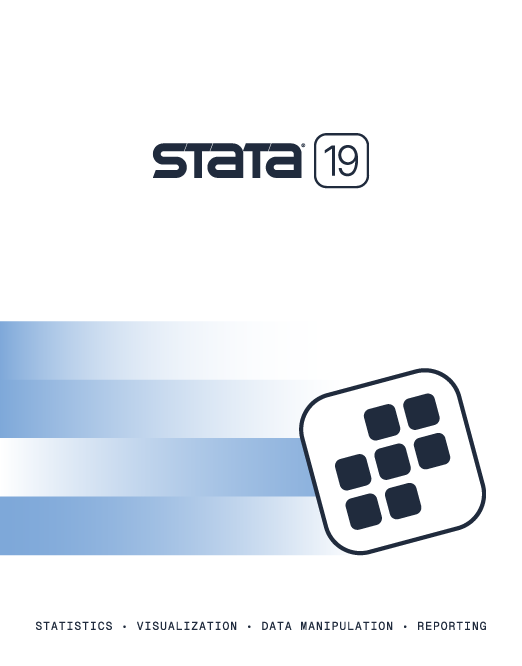Last updated: 7 January 2010
2009 Italian Stata Users Group meeting
Thursday, 19 November

Grand Hotel Baglioni Florence
Piazza Unità Italiana 6
Florence, Italy
Proceedings
Output processing and automatic reporting with Stata
Ben Jann
ETH Zurich
This talk illustrates how results from various Stata commands can be
processed efficiently for inclusion in customized reports. A two-step
procedure is proposed in which results are gathered and archived in the
first step and then tabulated in the second step. Such an approach
disentangles the tasks of computing results (which may take long) and
preparing results for inclusion in presentations, papers, and reports (which
you may have to do over and over). Examples using results from model
estimation commands and various other Stata commands such as tabulate,
summarize, or correlate are presented. Users will also be shown how to
dynamically link results into word processors or into LaTeX documents.
Additional information
italy09_jann.pdf
Covariate-adjusted cumulative incidence in the presence of competing risks
Enzo Coviello
Unità di Statistica ed Epidemiologia ASL BA/2, Giovinazzoo
Abstract not available.
Additional information
italy09_coviello.pdf
Frequentist and Bayesian stochastic frontier models in Stata
Federico Belotti
Università di Roma, “Tor Vergata”
Silvio Daidone
Università di Roma, “Tor Vergata”
Giuseppe Ilardi
Banca d’Italia, Economic and Financial Statistics Department
Abstract not available.
Additional information
italy09_daidone.pdf
Spatial indices of residential segregation
Maurizio Pisati
Università degli Studi di Milano—Bicocca
Abstract not available.
Additional information
italy09_pisati.pdf
Introduction to spatial-autoregressive models using Stata
David Drukker
StataCorp
This session offers an introduction to spatial econometrics using some
user-written Stata commands. I will discuss the estimation and
interpretation of the parameters in the cross-sectional
spatial-autoregressive model. Data management issues pertaining to
spatial-weighting matrices used in the analysis will also be addressed.
Additional information
italy09_drukker.pdf
Translation from narrative text to standard codes variables with Stata
Federico Belotti
Università di Roma, “Tor Vergata”
Domenico Depalo
Università di Roma, La Sapienza)
Abstract not available.
Additional information
italy09_belotti_depalo.pdf
Gestione di processi complessi da Stata
Rosa Gini
dell’Agenzia Regionale di Sanità della Toscana
Abstract not available.
Additional information
italy09_gini.pdf
Analisi statistica degli studi di coorte in Stata (in italiano)
Rino Bellocco
Università degli Studi di Milano—Bicocca
Il corso si propone di introdurre i partecipanti all’analisi statistica
degli studi di coorte in Stata, dove l’obiettivo principale èuello di
valutare l’associazione tra l’esposizione ad un fattore di rischio e
l’incidenza della malattia o la mortalità, in un certo intervallo temporale.
Il corso si propone di formalizzare in modo conciso alcuni aspetti
importanti di tali studi: la definizione di tasso di incidenza e la sua
relazione con l’incidenza cumulativa, la distribuzione di Poisson, il
confronto tra tassi di incidenza, sia crudo che aggiustato per il
confondimento, e infine valutazione dell’interazione. Una breve introduzione
all’analisi della sopravvivenza verrà fornita, per introdurre gli studenti
all’uso della procedura stset, utile e fondamentale per la regressione di
Poisson, qualora si debbano tenere in considerazione variabili tempo
dipendente. In particolare, verrà evidenziata: i) la potenza computazionale
del comando stsplit, che permette di generare records multipli; e ii) Il
confronto tra la regressione di Poisson e il modello di Cox. Infine,
verrà introdotto l’uso della standardizzazione, diretta e
indiretta.
Il corso è particolarmente adatto ai medici ed operatori in
sanità pubblica provenienti da istituzioni pubbliche e private che
vogliono imparare ad effettuare analisi degli studi di corte con Stata.
Requisiti per il corso: I partecipanti devono possedere conoscenze di base
di biostatistica ed epidemiologia.
Data visualization in Stata (in English)
Bill Rising
StataCorp
The Data Visualization in Stata course will be given by Bill Rising of
StataCorp. One of Stata’s strengths is the flexibility of its graphics,
because this flexibility allows creating custom graphs of great variety.
This short course will facilitate creation of custom graphs by showing how
to use the tools within Stata as well as by illustrating the thought process
behind custom graphs. We will start by covering the core toolbox of overlays,
marker symbols, and recasting together with careful data management.
Following this, we will look at using multiple axes and graph types to pack
extra information into the graph. We will look at changing the look of graphs
by using extra fonts and symbols as well as by controlling the look of the
graphics by using schemes. We will finish up with tools for on-the-fly mark-up
of graphs, which can be used for production of general custom graphs.
Course Requisites: No experience in programming or any other advanced Stata
knowledge is required.
Scientific organizers
Una-Louise Bell, TStat S.r.l.
[email protected]
Rino Bellocco, Karolinska Institutet
[email protected]
Giovanni Capelli, Università degli Studi di Cassino
[email protected]
Marcello Pagano, Harvard School of Public Health
[email protected]
Maurizio Pisati, Università degli Studi di Milano–Bicocca
[email protected]
Logistics organizers
TStat S.r.l, the official distributor
of Stata in Italy.

